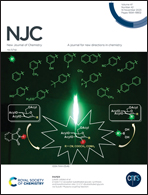A light- and redox-switchable tristable [3]rotaxane with orthogonal controllable shuttling of different wheels†
Abstract
While controlling the wheel shuttling of prototype [2]rotaxanes has been readily achieved, which promotes the development of intelligent supramolecular systems and materials, it remains a grand challenge to access higher ordered rotaxane systems with precisely controllable relative motion between component parts. Herein, a unique tristable [3]rotaxane was synthesized by threading two cyclobis(paraquat-p-phenylene) (CBPQT4+) macrocycles with a dumbbell component, which contained three recognition sites, including a photoactive azobenzene (AB) unit and a redox active tetrathiofulvalene (TTF) unit separated by a dioxynaphthalene (DNP) unit. Upon UV (365 nm)/yellow (> 525 nm) light irradiation, the Z/E photoisomerization of the AB unit could be triggered to drive the CBPQT4+ wheel (A) to shuttle between the AB and DNP units, with the CBPQT4+ wheel (B) maintained on the TTF unit. Furthermore, regulating the redox states of the TTF unit without light irradiation can induce the CBPQT4+ wheel (B) to shuttle between the TTF and DNP units. The construction of this unique orthogonal photo and redox stimuli-responsive [3]rotaxane is conducive to the development of higher ordered rotaxane-based molecular systems with controllable sophisticated properties and functions.
![Graphical abstract: A light- and redox-switchable tristable [3]rotaxane with orthogonal controllable shuttling of different wheels](/en/Image/Get?imageInfo.ImageType=GA&imageInfo.ImageIdentifier.ManuscriptID=D3NJ04164F&imageInfo.ImageIdentifier.Year=2023)


 Please wait while we load your content...
Please wait while we load your content...